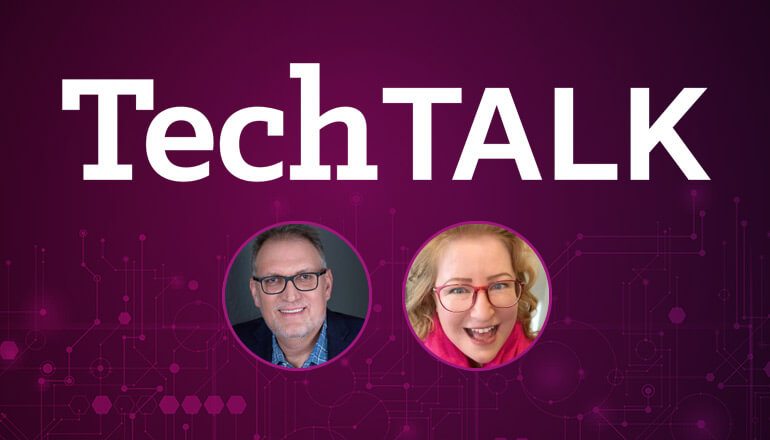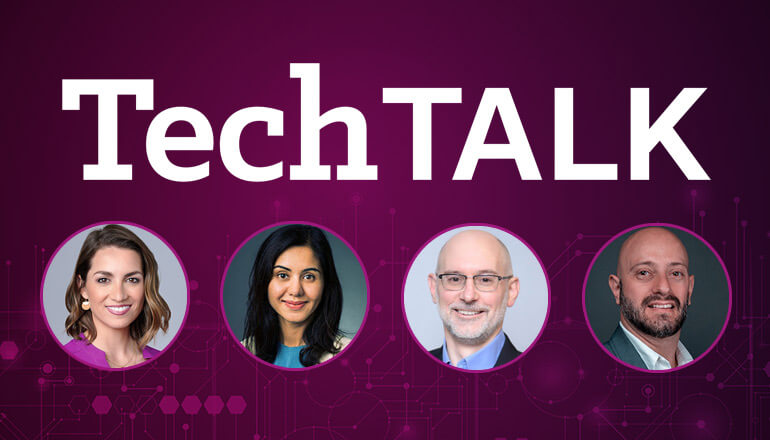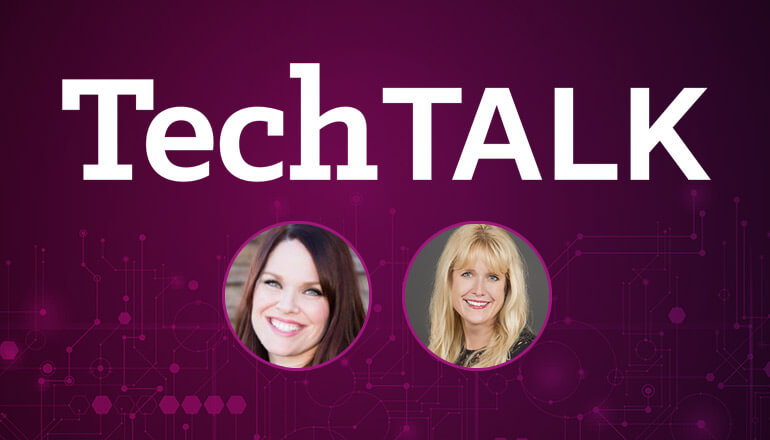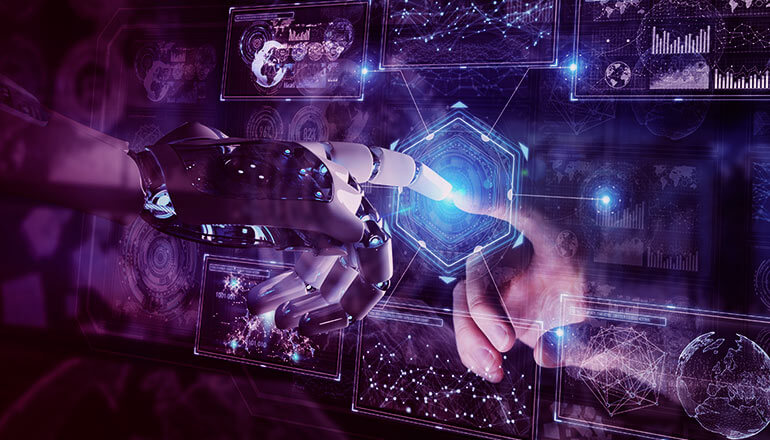Audio transcript:
Behind the Bot: Demystifying AI for Your Team
Erin
Hello and welcome to this episode of Insight's Tech Talk, where we connect with Insight's partners to discuss technology trends and industry advancements. I'm your host, Erin Hazen and today I'm joined by Corey Timmons who leads the global sales training team for Qualcomm. Thanks for being here today, Corey.
Corey
It's my pleasure. Thanks for having me, Erin.
Erin
Real pleasure to have you. And I'm excited to dive into this topic together, AI, it's in every headline, every news story, every LinkedIn post. And as AI continues to capture everyone's attention in the marketplace, having a better understanding of how immediate use cases for AI can help businesses advance starts with some information that I think sometimes gets a bit glossed over. And that's why you're here today, Corey, is we're going to talk about what is important to know about AI, and especially at that end user level. I guess in today's session we're going to start at AI at the edge. Does that sound okay to you?
Corey
Sounds great.
Erin
Perfect. Okay, so let's dive in. We've got a series of questions and I'm sure I'm going to pepper you with some additional information 'cause this topic is fascinating.
Corey
That's all right. I'm ready. I'm ready.
Erin
I love it. I love it. Let's talk about, first and foremost, can you help us by understanding what is exciting about AI right now?
Corey
Well, I mean, well there's a lot to be excited about, right? In AI, and it is a buzzword. Everybody's talking about it. There's a significant amount of development starting. So just the number of companies on the daily basis that are being created to start using these large language models. Things like chatGPT, how to actually create an app that will leverage stuff like that to make people more productive or more fun or whatever, right? So there's a lot of activity around AI, but there's also a lot of confusion around what is it going to do for workflow? What is it going to do? Is my job safe, right? Is AI going to replace us? Like, so there's that as well. But I think the most exciting part for me for AI as far as, you know, beyond like seeing beyond seeing video with your favorite actor maybe in every movie or those types of things. The exciting thing is to make us all more productive. But the most important thing to keep in mind today around AI is that these are sitting in large server farms. So when you think of something like a chatGPT, this is sitting in large server farms drawing a tremendous amount of power and it's not something that the average enterprise is going to be able to create. So right now it's about what, what's it going to be what is it going to look like, who's going to host it? What are the security concerns around it? And then how do I enable my users within my enterprise to be more productive by using it?
Erin
Right. And I think you nailed it. I think a lot of us are super excited to learn about AI and hear about how all of these really cool functions are going to take place. But then once we get into the weeds a little bit, oh, how does this actually all function and how much power is it going to take and how much compute is it going to take? And so that's, I think, a really important piece that Qualcomm plays in this factor. Maybe, sorry to put you on the spot here, just quickly, Corey but maybe if you can explain a little bit about Qualcomm's relationship with that sort of backend piece that would be really helpful.
Corey
Sure. Sure. So Qualcomm, we are a silicon provider. So we create processors, application processors for all different kinds of devices whether that's a phone or a wearable. That's where most of us have been. Well, many of you would probably know us from, right? It's in the mobile space. And so a lot of those AI use cases on a tablet or a phone, like a Snapchat, Filters, Instagram filters, those types of things that are running AI. That's where we have kind of been from, okay? So we create the silicon that can run that efficiently in those types of devices. And now you're also seeing that on the compute side.
Erin
Amazing. Such a key ingredient in this whole advancement in this technology is how is it functioning? How is it created? And then is it functioning efficiently? And then I guess how are end users using that efficiently? So getting into sort of that next topic that we wanted to talk about which is what would you say is most important to know about different on-device technologies?
Corey
Yeah, so we say on-device technology, that's great. So, you know, like I said, this AI is sitting in the cloud. So why does it matter what happens on my device if I'm just using a web browser to access it, right? That's the question of from an enterprise perspective why does that matter? Well, think about security. So just at Qualcomm, we deal with a lot of products that are that we're on NDA, very confidential, you know business critical things that we do not want sitting in an AI. We don't want that sitting in the cloud where maybe you go and ask it a question and says, hey, well why don't you talk about this? And it's something that we didn't even know was out there, right? So making sure I have security in the enterprise. So anything I put into the cloud I have to be very careful about. And more and more the algorithms, right? So things that maybe that's AI features for video, maybe it's AI features for audio, maybe it's AI features for productivity. Initially you see them come out in the cloud. But as those algorithms get refined, they need to be run on device to be secure and to be run at low power and to be run offline. And that's where you start to see a play for a Snapdragon device is because we are able to do that on device at very low power consumption. And you'll see more and more that happen as the industry matures as these large language models get created in the cloud they get optimized and then put onto a device that can run offline.
Erin
Okay. This is really interesting. So you mentioned Snapdragon. Can you tell me a little bit more about that technology? If you don't mind? Let's just get our viewers right into this.
Corey
Okay, great. So Snapdragon is our brand that has to deal with like what you'll see in a phone, right? So we have our Qualcomm brand which is more maybe from like robotics and things like that. And then we have our Snapdragon brand which is what your users and customers and salespeople will know. And that is, if you look for a Snapdragon powered Windows laptop that's what you'll see. So think of it just as a branding name but it's a bundle of technologies of premium experiences that we put together under the badge of Snapdragon.
Erin
I love it. I love it. And so when we had talked earlier we were chatting a little bit about how this is such an important piece of the puzzle. That's why I'm kind of hammering on it a little bit. Because in order for us to efficiently use AI, this kind of technology is a requirement not just a want to, it's a need to. So that we're not like running an AI function on our laptop and it lasts 30 seconds before it drains all of the power 'cause it's too much to use. Am I summarizing that correctly?
Corey
Yeah, you're pretty close, right? So I would say that when you think of how you're going to drive AI, right? These things are incredibly computationally intensive. So even the algorithm, even optimized algorithm it's not running just in memory. It needs to hit your CPU and your GPU to do that. So it's hitting two very inefficient engines when you're on a battery. Those are your two beefiest engines. And what you need to be able to do. But traditionally with an X86 platform, that's all you had. You had this engine and that engine and that's what you could do. And what you're going to see is as more and more AI use cases are being brought to Windows and on the device, that battery life is going to drain very quickly if you're running a lot of AI applications because you need to be able to run your background applications, you need to be able to run Word, you need to be able to run PowerPoint. So those things need to be offloaded. And what we do better than anybody is create dedicated engines to do dedicated tasks. And so we can run AI at an incredibly low power usage. And that lets you do all these things on the go on battery without using it up.
Erin
So this is the ticket. This is like, okay end users are going to need to be efficient organizers or organizations are going to want to have this kind of technology in order to leverage AI to better their business moving forward. I love this. This is really coming together. And I guess maybe one other question I have for you is does this have to do with a powerful neuro processor? That's another question we had kind of talked about a little bit.
Corey
Yeah, you'll hear that term, right? You'll hear a NPU or a neural processing unit, right? But it's whether you use an NPU or you use another dedicated architecture, it's really about creating something that is designed to run that sipping at a battery and not a CPU or a GPU, which aren't designed to do that. They're designed to do other things. And so you don't want to put you don't want to use a semi-truck right? To go to the mailbox and it's that type of thing, right? You're going to use too much fuel. And so it's really about how do you leverage the right engines correctly. And that's the most exciting part when you start looking at these true thin and light fanless designs that Windows Microsoft's bringing out with all of the OEMs is how do you do all that and run AI? Because AI is going to be ubiquitous and you have to be able to run it and you need to be able to run it on battery.
Erin
It's not going anywhere.
Corey
It's only going to get, it's going to be a huge piece. I mean, just stay tuned as we look at the fall and some of the announcements coming, it's very, very exciting where AI's going to help us all be more productive.
Eric
Totally. Totally. I personally cannot wait for the productivity piece to kick in. So this is all really fascinating. Is there anything that you would like to share more of Corey? Is there any sort of, you know tips or tricks or hints that you you would like to share with our viewers today about what this means for organizations and end users?
Corey
Well, I think the important thing is you need to start thinking about it now, right? So if you are an enterprise and you are still running on Windows 10, or you are not in a modern deployment type of environment, or you're not prepared for these types of applications, you need to start that now. So that's where I would encourage you to reach out to your partners at Insight to help you start building that roadmap, because you're going to need to be on Windows 11 to start supporting these use cases and your users are going to need these use cases very soon. So it's really about thinking about that. Now, I wouldn't assume that you haven't thought about it, but if you are kind of pushing it down the road, you really need to start having that conversation and Insight can help you do that. And then we have people within Qualcomm who can help you put that together as well. And partnership with Insight. And we look forward to that conversation. 'cause it is a journey. You need to make sure that your architecture your infrastructure is in place to support both Windows 11 modern deployment and then eventually AI.
Erin
And just like you said, the right partners to make sure that you feel like you can do this. Because it's interesting, I have clients myself who I've spoken with, we've talked about AI and some of them are, are pretty nervous and, you know how can we make sure that our that our environment is prepared, that our people are prepared, that we are secure, and you're exactly right. A bit of a roadmap or workshop where we can as as insight as a partner discuss and then say, hey, here's all of the technology available to you from Qualcomm, from Microsoft that is going to enable you to better use these initiatives to be more productive. Yeah, it all starts with that initial conversation and not being too scared of it. Right? We don't need to be scared.
Corey
No, I don't think you need to be scared. I mean, we should have policies. You don't want your people going out on their own, you know Google account to chatGPT and writing copy for your for your upcoming, you know, disclosure. You don't want that to be happening. Right? And so you need to start thinking about it. Are you going to build your own server farm? Probably not.
Erin
No.
Corey
You know, I would say that if you looked at any of the latest earnings announcements, for example, you know that's incredibly expensive for you to build out your own AI farm just to run it for your users. So you got to think about how are we going to start doing this? And yet you don't want to be afraid to say we're not going to allow any AI. Because the reality is there will be in the next five to 10 years, people who know how to use AI to be more productive and get more done. And those who don't know how to use it. So it's a fundamental transformative improvement in productivity that as you bring it to your users, you can be more dynamic, you can move faster, you can compete better when you start to use these tools effectively. But you got to think about security, you got to think about those policies now. And Insight can definitely help you do that.
Erin
Well, and it's so fun. These advancements, these leaps in technology you know, it's akin to before when we would just communicate by letters and then we move to email, and now it's a it's a non-starter that, that is just a requirement of our day-to-day. AI is going to be that next leap in technology where it is just a part of our everyday. So why not do the best you can to be prepared? Right?
Corey
Good question. I mean, if you look at just, even this presentation that's being recorded you know, this is going to be edited, right? And you're not shooting it on film. You're not cutting and splicing and putting it all together. Right? The digital editing rigs were created and it didn't make editors go away. If anything, it created millions of editors who are doing YouTube videos and all that. Right? So it's about now I can, as an individual I can start creating things and iterate faster because I have tools to help me. It's not going to replace me. It's going to help me be more effective in the future.
Erin
And free up that creative time for you to be able to to do that bigger thinking versus being bogged down with the stuff that maybe is not as productive.
Corey
There's no question. There's no question.
Erin
This is such a fascinating conversation, Corey. I wish we had more time. I really, really appreciate all of your insights and expertise and absolutely, the partnership that we have with Qualcomm is so valued. Thank you. Thank you so much for being here today.
Corey
It's my pleasure.
Erin
Great. And you can certainly learn more about the solutions available from Qualcomm by visiting insight.com and clicking on the Qualcomm partner portal. And while you're there, of course make sure you subscribe to our digital newsletter. It is called the Tech Journal and you will find much more inspiration and insights into the future of business and technology in that magazine. My name is Erin Hazen and on behalf of Insight it is always a pleasure to speak with you. We will look forward to Tech Talking again soon. Have a great day.








